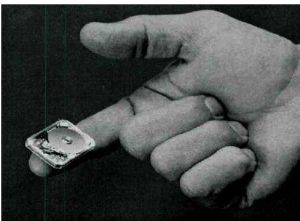History 2003: Incredible 0.85-Inch HDD by Toshiba
2GB or 4GB
By Jean Jacques Maleval | February 22, 2024 at 2:00 pmToshiba Storage Device Division unveiled for the first time at Las Vegas’ popular CES show the prototype of a stunning product, the first sub one-inch HDD, a unit in a 0.85-inch (21.6mm) form factor, i.e. with a surface area of only 24x32mm with thickness of either 3.3mm or 5mm, for 1 or 2 heads and 2GB or 4GB capacity, respectively.

This is less than half the volume of a one-inch unit, 10x less than the 1.8-inch HDD. The company has announced a 1,000G operating shock, never before attained with a HDD.
It’s quite a technological feat to place in so small a space a tiny motorized disk spinning at 3,600rpm, an actuator that also moves, supporting 1 to 2 heads, and finally the chipset with all the electronics. Its total weight is 10 grams (compared to 16 grams for a one-inch unit).
Its price, of course, will fall well below those of flash cards, which currently run close to $600 for 2GB, perhaps half that by the time Toshiba releases its microdrive.
The starting price is expected to be $280, but a price closer to $100-$150 doesn’t seem unreasonable once quantity production is underway.
Toshiba intends to start shipping evaluation units in summer 2004, with mass production in 4Q04 in the hope of shipping 300,000 units before the end of the year.
And it won’t be alone, since GSMagicstor, a new Chinese manufacturer of one-inch HDDs, has also announced the development of a teeny unit, this time an even smaller: 0.8-inch HDD.
The miniature scale should allow in particular manufacturers to integrate HDDs within the one mass consumer product in which they’ve been conspicuously absent: cellular phones, too small to fit a one-inch drive. The size of the memory could be very practical in new phones, allowing for the possibility of shooting digital images, even some form of longer videos, which normally consume a substantial number of megabytes.
As with the one-inch devices, the true competitors for the 0.85-inch units will be flash memories, but it’s significant that Toshiba, a flash leader, is leading the vanguard of the microdrive market, thus signaling that it believes that rotating magnetic memories, with greater capacities, can compete with silicon memory.
It’s also surprising to see some renewal in HDD industry around the smaller form factors, with the appearance of 2 start-ups, something we haven’t seen for some time, not since the arrival of Ritek/Microstor, a small form-factor venture that vanished in 2002.
There’s Cornice, with the support of SAE/TDK, as well as GS-Magicstor, which is relying on R&D from RioSpring, one of its major shareholders.
Throughout the history of the HDD, this is the first time a new form factor has not been introduced by an American firm (see table below).
Even more noteworthy is the complete absence in the sector of any traditional U.S. HDD manufacturers, be they Maxtor or Western Digital, both still exclusively in 3.5- inch technology, or Seagate, which just recently launched a 2.5-inch drive (and excluding IBM, the first to launch a one-inch device, until it sold its division to Hitachi).
Their thinking is fairly obvious: they’ll join the market when it’s large enough. Let others do the running while they wait patiently.
Will it be possible to go even smaller than 0.8- inch? It seems difficult to imagine, without turning to nanotechnologies.
Note, incidentally, that Toshiba is also Apple’s source for the successful iPod MP3 player – with more than 2 million units sold and soon to appear in HP’s catalogue – supplying a 1.8-inch drive. Toshiba began mass manufacture of 1.8- inch HDDs in 2000, and claims to have produced a total of 3 million units as of October 2003. The company skipped past one-inch units to head directly to the 0.85-inch form factor. HGST, with its one-inch 4GB unit, was selected as the supplier for the newest iPod Mini. Can we expect to see the new 0.85-inch HDD in the next-gen iPod Micro?

This article is an abstract of news published on issue 192 on January 2004 from the former paper version of Computer Data Storage Newsletter.













 Subscribe to our free daily newsletter
Subscribe to our free daily newsletter

